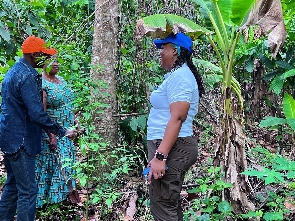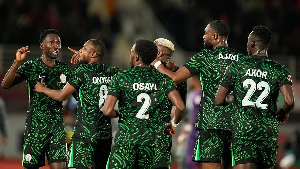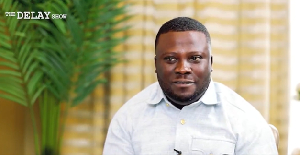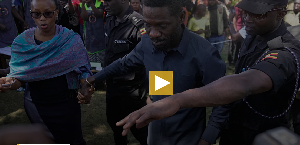Mary Adedzi a mother of four lives in the Saviefe Agorkpo community in the Ho West District Assembly of the Volta Region of Ghana. With broad smiles, she proudly recounts how her commitment to planting and taking care of trees on her farm years ago is yielding benefits. Today, her 12-year-old various economic tree species are a source of happiness.
“We were given seedlings, which we nursed and planted with crops on our cocoa farms a few years ago. My cocoa and crops have been maturing well because of the shades from the trees, and I must say I am happy I joined the initiative”, Mary narrated.
Mary’s community falls within the lowlands of Weto landscape which is about 344 hectares placed under the cocoa agroforestry. The landscape is well-endowed with a diversified natural resource base with rich endemic flora, wildlife, birds, and has a conducive climate.
However, in the recent past, the area suffered from extensive environmental degradation. This was due to uncontrolled wildfire, unsustainable farming
practices, and illicit harvesting of timber and wood fuel, resulting in the lose of at least 70 percent of the original habitat.
Looking back, Mary is proud of joining her peers to practice cocoa agroforestry where they were supported to integrate and manage economic trees with crops on their farms.
“I have been planting cocoa, yam, vegetables, plantain, avocado, and mangoes with trees on my farm. The crops provide food for me and my family, and I also sell some for income. I am happy to say that my firstborn is currently at the Nursing Training School and am able to take care of her education because of the profits I make from the farm”, Mary stated.
Mary is among the 3,500 direct beneficiaries supported in 2012 by the United Nations Development Programme (UNDP), under the UNDP Global Environment Facility Small Grant Programme (GEF/SGP), to help restore the degraded Weto landscape. The project dubbed “Community Development and Knowledge Management for the Satoyama Initiative (COMDEKS)’ was financed by the Japan Biodiversity Fund.
“I have also benefited a lot from the initiative. As a widow, my biggest joy is being able to send my daughter to university due to the profits I make from proceeds from my farm. I can say it is good to have the trees on our farms because we get good yields due to the shades”, noted Gladys Godzo, also in Saviefe Agorkpo.
Working together for nature
The project has formed the Weto Platform, made up of ten Civil Society Organizations in environmental protection, traditional authorities, Government institutions (such as Ministry of Food and Agriculture, Forestry Commission and District Assemblies), and the local communities. Coming together, the Weto
Platform has proven successful.
As a governing body, the Platform has supervised the conservation of
135,500 hectares of ridge forestland as a community-managed natural regeneration area. Out of this, 15,000 hectares have been placed under agroforestry and sustainable land management. In addition, seven watersheds have also been rehabilitated and restored, making these rivers perennial.
“If we destroy the environment, we destroy our sustenance. So, we are doing everything possible to protect the forest”, noted His Majesty, Osie Adza Terkpor VII, Paramount Chief of Avatime and President of the Avatime Traditional Council.
Forest restoration paving way for ecotourism
The multi-stakeholder approach has not only contributed to the restoration of the threatened landscape but is also promoting ecotourism, employment opportunities, and livelihood support systems in the Weto landscape. Part of the protected area is currently hosting the first canopy walkway in the Volta
Region at Amedzofe, offering rewarding recreational, health, and economic benefits to the indigenes and numerous visitors.
“We are conserving the area to protect endangered species particularly the slippery frogs and a portion of the proceeds from this ecotourism project is being shared with the community towards the community development”, noted Dr. Caleb Ofori Boateng, Founder of Herp Ghana Conservation, the non-governmental organization that built the first Volta Region’s canopy walkway and a member of the Weto Platform.
Community leadership is therefore central to the success of any climate action, as this allows exchange of rich traditional ecological knowledge, and stewardship. The success of the Weto landscape restoration cannot be told without the critical role played by the traditional authorities and individual community members like Mary and Gladys.
It is important to note that the climate emergency demands action from everyone individuals, Governments, and businesses. We must all lace up our shoes and join the race to net zero emissions toward a sustainable future.

Regional News of Thursday, 16 March 2023
Source: Praise Nutakor, Contributor













